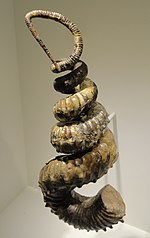
Back Ammonoidea Afrikaans أمونيت Arabic Ammonoidea AST Ammonoidealar Azerbaijani Аманіты (галаваногія) Byelorussian Амонити Bulgarian Ammonoidea BS Ammonits Catalan Ammonoidea CEB Amoniti Czech
| Ammonoite Temporal range: Devonian – Cretaceous
| |
|---|---|

| |
| Asteroceras | |
| Scientific classification | |
| Kingdom: | |
| Phylum: | |
| Class: | |
| Subclass: | Ammonoidea |
| Orders | |
|
Anarcestida; Clymeniida; Goniatitida; Prolecanitida; Ceratitida; Phylloceratida; Lytoceratida; Ammonitida; Ancyloceratina | |



Ammonites[1] were marine cephalopod molluscs of the subclass Ammonoidea.[2]
Their widely-known fossils show a ribbed spiral-form shell, in the end compartment of which lived the tentacled animal. These creatures lived in the seas from at least 400 to 65 million years ago. They became extinct at the K/T extinction event. Their nearest living relatives are the octopus, squid, cuttlefish and Nautilus.
Nine orders are recognised in the Ammonoidea: five in the Palaeozoic and four in the Mesozoic.
- ↑ meaning 'ram-horned', from the Egyptian god Amun.
- ↑ Monks, Neale and Palmer, Phil. 2002. Ammonites. London: Natural History Museum.
© MMXXIII Rich X Search. We shall prevail. All rights reserved. Rich X Search